

In the 1939 notes and also in the 1961 version of Golden Hammer there is scant detail about the merger that created ‘King & Munk’. The 1939 notes state that the combination occurred ‘on the death of John Garton on March 21st 1867’ and that it was not a ‘happy arrangement’. The 1961 Golden Hammer is a little bit more specific stating the partnership occurred ‘two years after’ the date of death which suggests around 1869 or 1870. Both accounts imply the partnership was dissolved either ‘within’ or ‘after about’ a year. This depends on which version you read - these being 1939 Notes Chapter ‘Greater Yet’ last paragraph, or Chapter 6 of Golden Hammer, first paragraph.
I have attempted to investigate the timeline of events that led up to this not quite so short lived but possibly unhappy partnership, aided by information that Dad provided in 1996 and reference to newspaper archives and our own material. The date of the formation of the partnership is way off as the evidence below shows, and the duration suggested by either history is also somewhat adrift.

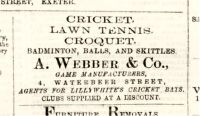 The ultimate merger between Munk and Garton & King to become King & Munk involved two businesses on the Munk side of the fence. Much of the background information is gleaned from local newspaper Notices and Advertisements but even that information presents queries.
The ultimate merger between Munk and Garton & King to become King & Munk involved two businesses on the Munk side of the fence. Much of the background information is gleaned from local newspaper Notices and Advertisements but even that information presents queries.
From at least as far back as 1844 John Webber carried out his business as an Ironmonger in Waterbeer Street, probably No 4, in Exeter’s City Centre.
Our first Advert dated 18th June 1874 shows the company now trading as A. Webber and Company and still under that name in 1876, ‘Game Manufacturers’ and popularly known as The Exeter Toolchest. An 1891 Situations Wanted advertisement for a Country Smith (None need apply but a Good Workman), refers to the company as Webber Sons and Company, Ironmongers, Waterbeer Street.
 Similarly we find a William Munk trading as a Wholesale Ironmonger in Rack Street in the early 1840s, and subsequently relocating to 135 Fore Street Hill, Exeter around 1853. The business was probably founded at the turn of the 19th century and in due course passed through the family and by the early 1880s was in the control of Edwin Isaac Munk.
Similarly we find a William Munk trading as a Wholesale Ironmonger in Rack Street in the early 1840s, and subsequently relocating to 135 Fore Street Hill, Exeter around 1853. The business was probably founded at the turn of the 19th century and in due course passed through the family and by the early 1880s was in the control of Edwin Isaac Munk.
 In 1996 my father was visited by John Trott who showed my father the diary of his grandfather, surname Bidgood, who was an apprentice and assisted Munk. The Diary records that on the 14th October 1882 Munk announced he was going into partnership with (John Gould) King, of Garton & King with Munk obviously taking over the Ironmongery side of G & K. This is confirmed by this notice placed in the Exeter & Plymouth Gazette dated 1st January 1883.
In 1996 my father was visited by John Trott who showed my father the diary of his grandfather, surname Bidgood, who was an apprentice and assisted Munk. The Diary records that on the 14th October 1882 Munk announced he was going into partnership with (John Gould) King, of Garton & King with Munk obviously taking over the Ironmongery side of G & K. This is confirmed by this notice placed in the Exeter & Plymouth Gazette dated 1st January 1883.
Back in 1996 my father believed little evidence existed of the partnership between King and Munk, other than an Iron Soot / Flue Door located on a chimney at Maynard School. As it happens since then a variety of evidence of this partnership has surfaced. On the Municipal Castings page is a small manhole cover 9” x 9” located at Luscombe Castle, Dawlish and below is shown a Soot / Flue Door actually in my possession. Here is also a document from the records of St Petrocks Church that not only refers to King & Munk but also to Garton & King, all on the same page and covering the period Easter 1885 - Easter 1886.
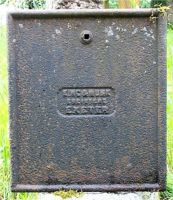
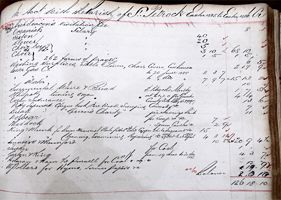
Left -King & Munk Flue Door, Right - King & Munk and Garton & King mentioned together in St Petrock accounts
My father referred to an Ironmongers Valuation that covered Garton & King and Munk’s business. This was carried out by a John Coppick, Licensed Valuer of East Street, Birmingham and is dated 18th December 1882. It divides the valuation, amounting in total to £13,366.11.4d.
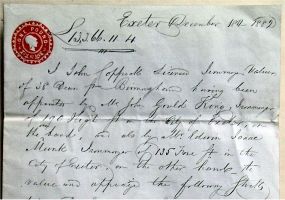
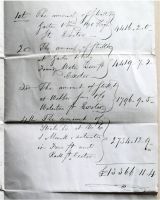
Valuation of the combined stock in 1882
| The Ironmongery Stock at 190 High Street | £4,416.02.00d |
| The Stock at Waterbeer St. Foundry | £4,418.07.02d |
| The Stock at Webber Sons & Co. | £1,796.09.05d |
| J Munk Stock at Rack St. & Fore St. | £2,734.12.09d |
Unfortunately quite why the partnership failed is not known. The initial advertisements dated 1883 and seen here and on the Flying the Flag page where the new company King & Munk exhibited at Shows and promoted the business in the newspapers suggests all is well.
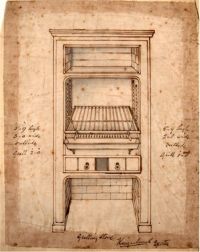 I have included a drawing found in the archives of a Stove signed at the bottom ‘King & Munk’, and examples of a couple of Rubber Stamps and a King & Munk invoice dated December 1884 are to be seen on the Stationery page.
I have included a drawing found in the archives of a Stove signed at the bottom ‘King & Munk’, and examples of a couple of Rubber Stamps and a King & Munk invoice dated December 1884 are to be seen on the Stationery page.
So, unfortunately the Munk, E. affair came to an end as this advert placed in the Exeter & Devon Daily Gazette on the 27th of November 1885 states, but for some reason the date that the Dissolution of the Agreement is to take effect from is back dated to ‘the 30th day of June last’. However, we do now know that the formal partnership lasted for 2 years and 5 months, from 1st January 1883 to 30th June 1885.
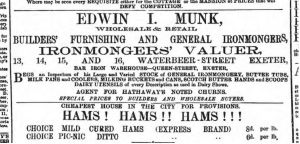 The last Newspaper Cutting is dated the 8th June 1889 and is from the Western Times. Edwin Isaac Munk reverted back to a business in its own right and continued to trade, at the time of the advert at least, from 13, 14, 15 & 16 Waterbeer Street as Builders and General Ironmongers as well as, curiously, Ironmongers‘ Valuer.
The last Newspaper Cutting is dated the 8th June 1889 and is from the Western Times. Edwin Isaac Munk reverted back to a business in its own right and continued to trade, at the time of the advert at least, from 13, 14, 15 & 16 Waterbeer Street as Builders and General Ironmongers as well as, curiously, Ironmongers‘ Valuer.
The business was, possibly in the late 1940s or early 1950s ‘absorbed into, or taken over by the established Ironmongers, Walter Otton, Fore Street, Exeter. No information has come to hand about the subsequent continuance of the business but even that name has disappeared and is remembered by those ‘of a certain age’!
Edwin Isaac Munk died aged 88 years on the 6th March 1922.
So, the end of a short lived ‘affair’ and possibly a costly one.
January 2021
Top of page
See also:
High Street — 144 Years of Newspaper Ads
Waterbeer Street Foundry — St Petrocks
Sitemap / Contents